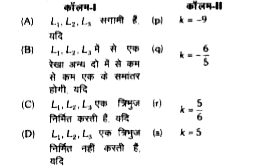यदि sr=αr+βr+γr तब ∣∣ ∣∣s0s1s2s1s2s3s2s3s4∣∣ ∣∣ का मान के बराबर है
0
(α−β)(β−γ)(γ−α)
(α+β+γ)6
(α−β)2(β−γ)2(γ−α)2
The correct Answer is:D
Step by step video, text & image solution for यदि s_(r)=alpha^(r)+beta^(r)+gamma^(r) तब |(s_(0),s_(1),s_(2)),(s_(1),s_(2),s_(3)),(s_(2),s_(3),s_(4))| का मान के बराबर है by Maths experts to help you in doubts & scoring excellent marks in Class 12 exams.
Updated on:21/07/2023Topper's Solved these Questions
- सारणिक तथा आव्यूह Book:ERRORLESS HINDIChapter:सारणिक तथा आव्यूह Exercise:JEE ADVANCED MORE THAN ONE CORRECT ANSWERS
Explore 66 Videos
- सारणिक तथा आव्यूह Book:ERRORLESS HINDIChapter:सारणिक तथा आव्यूह Exercise:JEE ADVANCED MORE THAN ONE CORRECT ANSWERS (Comprehension type questions) (Passage-I)
Explore 6 Videos
- सारणिक तथा आव्यूह Book:ERRORLESS HINDIChapter:सारणिक तथा आव्यूह Exercise:Solved Multiple Choice Questions ( आव्यूह के प्रकार, आव्यूह का बीजगणित)
Explore 130 Videos
- सरल रेखा Book:ERRORLESS HINDIChapter:सरल रेखा Exercise:JEE ADVANCE (Matrix Match type questions)
Explore 4 Videos
Similar Questions
सारणिक ∣∣ ∣∣abaα+bbcbα+caα+bbα+c0∣∣ ∣∣=0 यदि
View Solutionमाना कि p एक विषम अभाज्य संख्या है तथा Tp,2×2 आव्यूहों का निम्न समुच्चय है
Tp={A=[abca]:a,b,c∈{0,1,2,.............p−1}}
Tp में ऐसे A की संख्या जो सममित या विषम सममित अथवा दोनों प्रकार के हो एवं जिनके लिए det(A),p से विभाज्य है, निम्न है
View Solutionयदि M=[1223] और M2−λM−I2=0 तब λ=
View Solution
View SolutionIf S_(r)=alpha^(r)+beta^(r)+gamma^(r) then show that det[[S_(2),S_(1),S_(2)S_(1),S_(2),S_(3)S_(2),S_(3),S_(4)]]=(alpha-beta)^(2)(beta-gamma)^(2)(gamma-alpha)^(2)det[[S_(1),S_(2),S_(3)S_(2),S_(3),S_(4)]]=(alpha-beta)^(2)(beta-gamma)^(2)(gamma-alpha)^(2)
View SolutionIf S1,S2,S3 be respectively the sums of n,2n,3n terms of a G.P., then prove that (S1)2+(S2)2=S1(S2+S3) .
View SolutionIf Sr=αr+βr+γr then show that ∣∣ ∣∣S0S1S2S1S2S3S2S3S4∣∣ ∣∣=(α−β)2(β−γ)2(γ−α)2
View SolutionConsider the sequence of natural numbers s_(0),s_(1),s_(2),... such that s_(0)=3,s_(1)=3 and s_(n)=3+s_(n-1)s_(n-2) then
View SolutionIf s_(1),s_(2)s_(3),......s_(r) are the sum of the products of the roots taken rat a time then for 2x^(9)-5x^(4)+k=0,s_(r)=16rArr k=
View SolutionIf S_(r) denotes the sum of the first r terms of an A.P.then show that (S_(3r)-S_(r-1))/(S_(2r)-S_(2r-1)) is equals
View SolutionIf S1,S2,S3be respectively the sum of n,2n and 3n terms of a GP, then S1(S3−S2)(S2−S1)2 is equal to
View SolutionIf S1=n∑r=1r,S2=n∑r=1r2,S3=n∑r=1r3 then : limn→∞S1(1+S88)(S2)2 =
View Solutionयदि गु० श्रे० के n,2n,3n पदों का योग क्रमशः S1,S2,S3 हों तो सिद्ध करें की S21+S22=S1(S2+S3).
View Solutionα,β,γ are the roots of the cubic equation x3+p1x2+p2x+p3=0. If Sr=αr+βr+γr,S1=10,S2=38 and S3=−1840, then p3=
View Solutionα,β,γ are the roots of the cubic equation x3+p1x2+p2x+p3=0. If Sr=αr+βr+γr,S1=10,S2=38 and S3=−1840, then p3=
View SolutionIf s1,s2,s3...sr are the sum of the products of the roots taken 'r' at a time then for x5−x2+4x−9=0, then s3+s4−s5=
View Solution